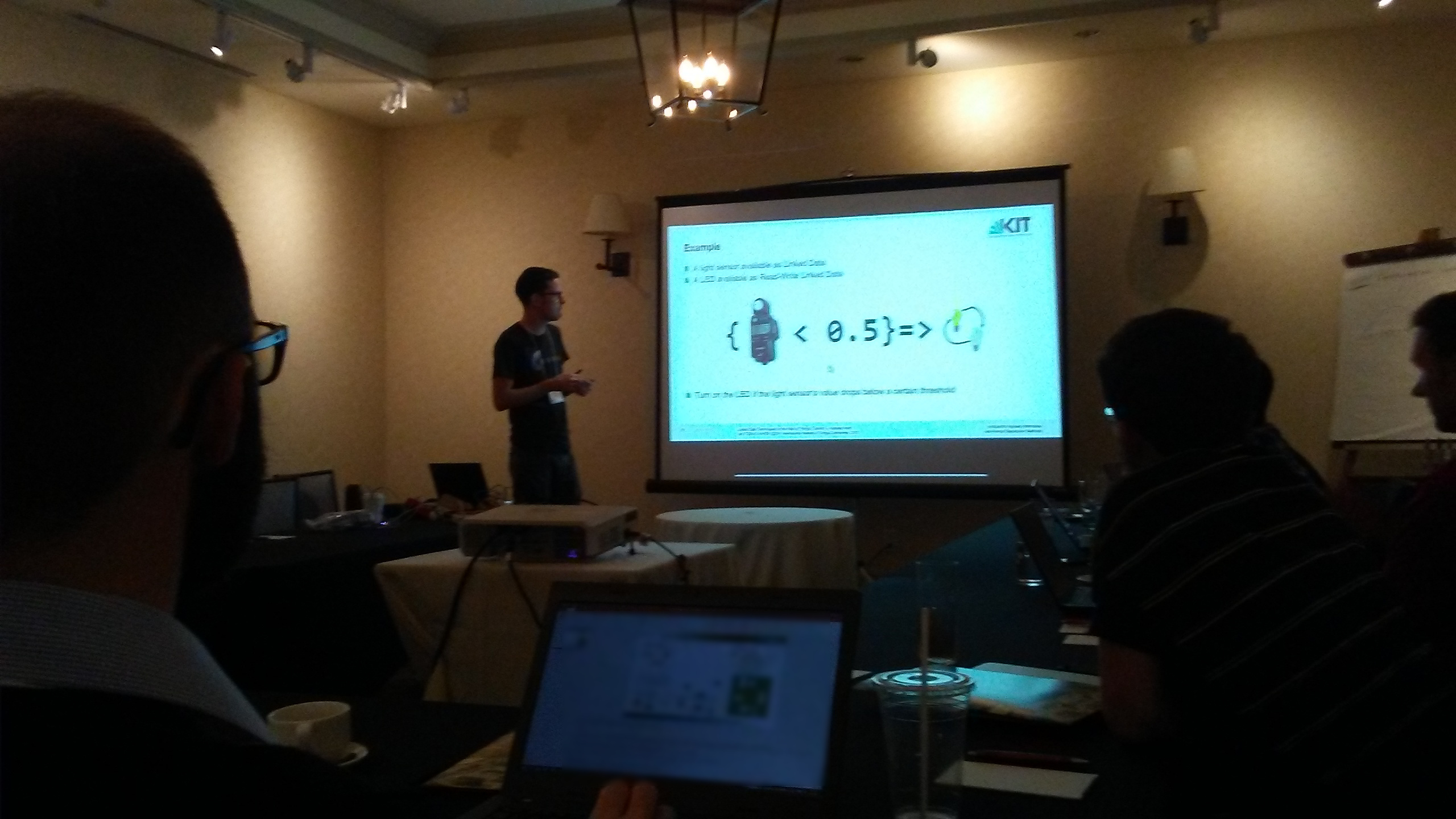Tutorial at the 8th International Conference on the Internet of Things (IoT 2018)
October 15, 2018
Santa Barbara, California, USA
Andreas Harth and Tobias Käfer
Cite as: Andreas Harth and Tobias Käfer. "Linked Data Techniques for the Web of Things: Tutorial". Proceedings of the 8th International Conference on the Internet of Things, Santa Barbara, California, 2018.
https://dl.acm.org/citation.cfm?id=3277641
Tutorial: Linked Data Techniques for the Web of Things (PDF)
The tutorial covers web technologies for specifying and executing applications around networked sensors and actuators based on a logical representation of state and application behaviour.
Andreas Harth, Tobias Käfer. Tutorial: Linked Data Techniques for the Web of Things, 8th International Conference on the Internet of Things (IoT 2018), Santa Barbara, CA, October 15, 2018.

Interoperability is a major challenge on the Internet of Things: Different system vendors follow different paradigms in system architecture and data modelling, which makes the combination of heterogeneous devices into applications difficult. Hence, people from industry and academia have started to use web technologies, which are built for large-scale interoperability based on open standards, to address the interoperability challenge on the Internet of Things. Recently, standardisation of the work in the Internet of Things domain has started and the first standards have been published: The Thing Description recommendation by the W3C's Web of Things Interest Group allows to describe device capabilities, the W3C's SSN and SOSA recommendations by the Spatial Data on the Web Working Group allows to describe the domain of systems, sensors, actuators, observations and actuations, and iotschema.org serves as consolidation effort. Those standards allow to provide descriptions in data formats that make a light-weight use of semantic technologies.
In this tutorial, we cover light-weight semantic web technologies, commonly dubbed as Linked Data, for the Internet of Things community to fully exploit the standardisation efforts. We present the technology stack of Linked Data, address conceptual differences with other technology stacks for the Internet of Things, and show how to use Linked Data-based access to build applications on the Internet of Things.
The Linked Data community has been around for more than ten years. The term Linked Data has been coined around 2006 and is, roughly speaking, the combination of the communication protocol HTTP (of which REST is the architectural style) and the data model RDF, which are well-established web technologies developed in the 1990s. Starting in the early 2000s, people from embedded systems have started to use HTTP/REST for accessing small-scale sensor-equipped devices, see e.g., Borriello and Want (2000): Embedded Vomputation Meets the World Wide Web, Kindberg et al. (2000): People, places, things: Web presence for the real world, Yazar and Dunkels (2009): Efficient application integration in IP-based sensor networks. The semantic technologies around RDF are a more recent addition to the Internet of Things, see e.g., Sheth et al. (2008): Semantic Sensor Web, Kovatsch et al. (2015): Practical semantics for the Internet of Things: Physical states, device mashups, and open questions. The corresponding communities gather around the Schema.org IoT Sync discussion list with 100 subscribers, and the W3C Web of Things Interest Group with close to 200 group participants.
We previously held the tutorial in May 2017 at the 14th European Semantic Web Conference (ESWC). The tutorial material of the ESWC edition is available online. The updated version for the IoT Conference 2018 will incorporate the lessons learnt from the ESWC edition and be adapted for the IoT domain.
Andreas Harth holds the Chair of Technical Information Systems, Friedrich-Alexander-University Erlangen-Nuremberg and leads a department at Fraunhofer IIS - Center for Applied Research on Supply Chain Services SCS. He worked as a post-doctoral researcher at Institute AIFB at the Karlsruhe Institute of Technology (KIT) after pursuing a Ph.D. at the Digital Enterprise Research Institute (DERI) at the National University of Ireland, Galway. Andreas has over seven years of teaching experience and gave tutorials at the ISWC, ESWC, SIGMOD, and WWW conferences.
Tobias Käfer is a Ph.D. candidate at the Institute AIFB, Karlsruhe Institute of Technology (KIT) in Germany working under the supervision of Andreas Harth and York Sure-Vetter. His research is centered around the formalisation, observation, and execution of behaviour for the Linked Data Web applied to the Internet of Things. He was visiting researcher at the University of Chile and worked as an intern at DERI, IBM, and Siemens. He was tutor for various computer science lectures at KIT and gave a tutorial at ESWC.